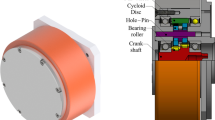Abstract
The cycloid planetary gear reducers are widely applied in automation machinery. Even having the advantages of high gear ratio, multiple contact tooth pairs and shock absorbing ability, how to enlarge the power density of the drives is still the essential development work today. To this end, the concept of tooth number difference of two is proposed. The aim of the paper is to analyze systematically the loaded contact characteristic of such the cycloid planetary gear drives so as to evaluate the feasibility. A set of essential equations for the cycloid profile, the tooth contact and the specific sliding of the cycloid stage are at first derived in the paper. A loaded tooth contact analysis approach is extended from a developed model based on the influence coefficient method. The influences of the design parameters on the contact characteristics are systematically analyzed with an example. These results are also compared with the conventional drive having tooth number difference of one. The analysis results show that the proposed concept with a larger eccentricity and a smaller pin radius can not only effectively enlarge the contact ratio, but also reduce the specific sliding, the shared loads and the contact stress. Although the radial portion of the bearing load can be also reduced accordingly, the total periodical time-variant bearing load can not be reduced effectively by using the concept of tooth number difference of two.
























Similar content being viewed by others
References
Transcyko (2011) Transmission machinery. http://www.transcyko-transtec.com/. Accessed 01.07.2017
Tsai SJ, Huang CH, Yeh HY, Huang WJ (2015) Loaded tooth contact analysis of cycloid planetary gear drives doi:10.6567/iftomm.14th.wc.os6.014
Tsai SJ, Huang WJ, Huang CH (2015) A computerized approach for load analysis of planetary gear drives with epitrochoid-pin tooth-pairs. VDI-Berichte 2255.1., pp 307–317
Ivanović L, Josifović D (2006) Specific sliding of trochoidal gearing profile in the gerotor pumps. FME Trans 34:121–127
Blagojevic M, Marjanovic N et al (2011) A new design of a two-stage cycloidal speed reducer. J Mech Des N Y 133:085001–085001
Kim YH, Lee CS, Ahn HJ (2009) Torsional rigidity of a cycloid drive considering finite bearing and Hertz contact stiffness. Proceedings of the JSME international conference on motion and power transmission: MPT2009-Sendai, Matsushima isles resort, 13–15 May 2009
Thube SV, Bobak TR (2012) Dynamic analysis of a cycloidal gearbox using finite element method. AGMA technical paper 12FTM18.
Li S (2014) Design and strength analysis methods of the trochoidal gear reducers. Mech Mach Theory 81:140–154
Ishida T, Hidaka T et al (1996) Bending stress and tooth contact stress of cycloid gear with thin rims. Trans JSME Ser C 62(593):291–297
Dong X, Deng J, Chen J (1996) Force analysis of RV transmission mechanism. J Shanghai JT Univ 30(5):65–70 (84)
Blanche JGD, Yang CH (1989) Cycloid drives with machining tolerances. J Mech Trans Autom Des 111:337–344
Yang DCH, Blanche JG (1990) Design and application guidelines for cycloid drives with machining tolerances. Mech Mach Theory 25:487–501
Hidaka T, Wang HY et al (1994) Rotational transmission error of K‑H-V-planetary gears with cycloid gear, 1st report, analytical method of the rotational transmission error. Trans JSME Ser C 60(570):645–653
Gorla C, Davoli P et al (2008) Theoretical and experimental analysis of a cycloidal speed reducer. J Mech Des N Y 130(11):112604. doi:10.1115/1.2978342
Wu SH, Tsai SJ (2009) Contact stress analysis of skew conical involute gear drives in approximate line contact. Mech Mach Theory 44:1658–1676
Tsai SJ, Huang CH (2017) A study on loaded tooth contact analysis of a cycloid planetary gear reducer considering bearing roller stiffness. Proceedings of MPT2017-Kyoto
Acknowledgements
The authors would like to thank the Ministry of Science and Technology, Taiwan (MOST105-2221-E-08-042 -MY3) and Transmission Machinery Co., Ltd., Taiwan for their financial support.
Author information
Authors and Affiliations
Corresponding author
Rights and permissions
About this article
Cite this article
Tsai, SJ., Chang, LC. & Huang, CH. Design of cycloid planetary gear drives with tooth number difference of two. Forsch Ingenieurwes 81, 325–336 (2017). https://doi.org/10.1007/s10010-017-0244-y
Received:
Published:
Issue Date:
DOI: https://doi.org/10.1007/s10010-017-0244-y




